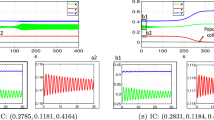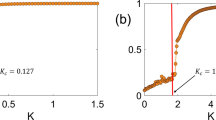Abstract
Effect of anti-predator defense due to fear of predator felt by prey and effect of toxic substance released by external sources on prey–predator system is a serious mater of concern in mathematical biology. In the proposed model we have discussed a prey–predator system in which both the species are infected by environmental toxicant. In our consideration prey species is directly infected by environmental toxicant and predator gets infected by consuming infected prey. Prey’s growth rate is assumed to be affected by fear of predator. In this work the proposed predator–prey model is analyzed in presence of environmental fluctuation, i.e., stochastic analysis of this model is discussed. Using Itô formula: positivity, boundedness, uniform continuity criterion and global attractivity of solutions of this system have been established. Conditions for which the prey as well as the predator goes extinct have been derived. Conditions for persistence of the system have also been discussed. Mathematical findings have been validated in numerical simulation by MATLAB. Different effects of different levels of toxicant and different levels of fear have been demonstrated by depicting figures in numerical simulation using MATLAB.









Similar content being viewed by others
References
Altendorf, K.B., Laundre, J.W., Gonzalez, C.A.L., Brown, J.S.: Assessing effects of predation risk on foraging behavior of mule deer. J. Mammal. 82(2), 430–439 (2011)
Boonstra, R., Hik, D., Singleton, G.R., Tinnikov, A.: The impact of predator-induced stress on the snowshoe hare cycle. Ecol. Monogr. 68, 371–394 (1998). https://doi.org/10.2307/2657244
Creel, S., Christianson, D., Liley, S., Winnie Jr., J.A.: Predation risk affects reproductive physiology and demography of elk. Science 315(5814), 960 (2007). https://doi.org/10.1126/science.1135918
Creel, S., Christianson, D.: Relationships between direct predation and risk effects. Trends Ecol. Evol. 23, 194–201 (2008)
Cresswell, W.: Predation in bird populations. J. Ornithol. 152, 251–263 (2011)
Das, A., Samanta, G.P.: Stochastic prey–predator model with additional food for predator. Phys. A Stat. Mech. Appl. 512, 121–141 (2018). https://doi.org/10.1016/j.physa.2018.08.138
Das, A., Samanta, G.P.: Modelling the fear effect on a stochastic prey–predator system with additional food for predator. J. Phys. A Math. Theor. 51, 465601 (2018). https://doi.org/10.1088/1751-8121/aae4c6
Das, A., Samanta, G.P.: A prey–predator model with refuge for prey and additional food for predator in a fluctuating environment. Phys. A Stat. Mech. Appl. 538, 122844 (2020). https://doi.org/10.1016/j.physa.2019.122844
Das, M., Samanta, G.P.: A delayed fractional order food chain model with fear effect and prey refuge. Math. Comput. Simul. 178, 218–245 (2020a)
Das, M., Samanta, G.P.: A prey–predator fractional order model with fear effect and group defense. Int. J. Dyn. Control (2020b). https://doi.org/10.1007/s40435-020-00626-x
Dubey, B., Hussain, J.: A model for the allelopathic effect on two competing species. Ecol. Modell. 129, 195–207 (2000)
Eggers, S., Griesser, M., Ekman, J.: Predator-induced plasticity in nest visitation rates in the Siberian jay (Perisoreus infaustus). Behav. Ecol. 16(1), 309–315 (2005). https://doi.org/10.1093/beheco/arh163
Ghalambor, C.K., Peluc, S.I., Marti, T.E.: Plasticity of parental care under the risk of predation: how much should parents reduce care? Biol. Lett. 9(4), 20130154 (2013). https://doi.org/10.1098/rsbl.2013.0154
Ghosh, J., Sahoo, B., Poria, S.: Prey–predator dynamics with prey refuge providing additional food to predator. Chaos Solitons Fract. 96, 110–119 (2017)
Hallam, T.G., Clark, C.W.: Non-autonomous logistic equations as models of populations in a deteriorating environment. J. Theor. Biol. 93, 303–311 (1982)
Hallam, T.G., Luna, T.J.: Effects of toxicants on populations: a qualitative approach III, environmental and food chain pathways. Theor. Biol. 109, 411–429 (1984)
Holling, C.S.: The functional response of predator to prey density and its role in mimicry and population regulation. Mem. Ent. Soc. Can. 45, 5–60 (1965)
Hua, F., Fletcher, R.J., Sieving, K.E., Dorazio, R.M.: Too risky to settle: avian community structure changes in response to perceived predation risk on adults and offspring. Proc. R. Soc. B Biol. Sci. 280(1764), 20130762 (2013). https://doi.org/10.1098/rspb.2013.0762
Hua, F., Sieving, K.E., Fletcher, R.J., Wright, C.A.: Increased perception of predation risk to adults and offspring alters avian reproductive strategy and performance. Behav. Ecol. 25(3), 509–519 (2014). https://doi.org/10.1093/beheco/aru017
Ji, C., Jiang, D.: Dynamics of a stochastic density dependent predator–prey system with Beddington–DeAngelis functional response. J. Math. Anal. Appl. 381, 441–453 (2011)
Kar, T.K., Chaudhuri, K.S.: On non-selective harvesting of two competing fish species in the presence of toxicity. Ecol. Modell. 161, 125–137 (2003)
Krapivsky, P.L., Redner, S.: Kinetics of a diffusive capture process: lamb besieged by a pride of lions. J. Phys. A Math. Gen. 26(17). http://stacks.iop.org/0305-4470/29/i=17/a=011 (1996)
Lande, R.: Risks of population extinction from demographic and environmental stochasticity and random catastrophes. Am. Nat. 142, 911–927 (1993)
Mao, X.: Stochastic Differential Equations and Applications. Horwood, New York (1997)
Mao, X.: Stochastic Differential Equations and Applications. Woodhead Publishing, Oxford (2011)
May, R.M.: Stability in randomly fluctuating deterministic environments. Am. Nat. 107, 621–650 (1973)
Mondal, S., Maiti, A., Samanta, G.P.: Effects of fear and additional food in a delayed predator–prey model. Biophys. Rev. Lett. 13(4), 157–177 (2018)
Mondal, S., Samanta, G.P.: Dynamics of a delayed predator–prey interaction incorporating nonlinear prey refuge under the influence of fear effect and additional food. J. Phys. A Math. Theor. 53, 295601 (2020)
Mondal, S., Samanta, G.P.: Time-delayed predator–prey interaction with the benefit of antipredation response in presence of refuge. Z. Naturforschung A (2020). https://doi.org/10.1515/zna-2020-0195
Pangle, K.L., Peacor, S.D., Johannsson, O.E.: Large nonlethal effects of an invasive invertebrate predator on zooplankton population growth rate. Ecology 88, 402–412 (2007)
Peacor, S.D., Peckarsky, B.L., Trussell, G.C., Vonesh, J.R.: Costs of predator-induced phenotypic plasticity: a graphical model for predicting the contribution of nonconsumptive and consumptive effects of predators on prey. Oecologia 171(1), 1–10 (2013). https://doi.org/10.1007/s00442-012-2394-9
Peckarsky, B.L., Cowan, C.A., Penton, M.A., Anderson, C.: Sublethal consequences of streamdwelling predatory stoneflies on mayfly growth and fecundity. Ecology 74, 1836–1846 (1993). https://doi.org/10.2307/1939941
Pettorelli, N., Coulson, T., Durant, S.M., Gaillard, J.M.: Predation, individual variability and vertebrate population dynamics. Oecologia 167(2), 305–314 (2011). https://doi.org/10.1007/s00442-011-2069-y
Preisser, E.L., Bolnick, D.I.: The many faces of fear: comparing the pathways and impacts of nonconsumptive predator effects on prey populations. PlOS One 3(6), e2465 (2008). https://doi.org/10.1371/journal.pone.0002465
Samanta, G.P.: Influence of environmental noises on the Gomatam model of interacting species. Ecol. Modell. 91(1–3), 283–291 (1996)
Samanta, G.P.: A two-species competitive system under the influence of toxic substances. Appl. Math. Comput. 216(1), 291–299 (2010)
Samanta, G.P., Maiti, A.: Stochastic Gomatam model of interacting species: non-equilibrium fluctuation and stability. Syst. Anal. Modell. Simul. 43, 683–692 (2003)
Schwarzl, M., Godec, A., Oshanin, G., Metzler, R.: A single predator charging a herd of prey: effects of self volume and predator–prey decision-making. J. Phys. A Math. Theor. 49, 225601 (2016)
Smith, M.J.: Models in Ecology, p. 146. Cambridge University Press, Cambridge (1974)
Suraci, J.P., Clinchy, M., Dill, L.M., Roberts, C., Zanette, L.Y.: Fear of large carnivores causes a trophic cascade. Nat. Commun. (2016). https://doi.org/10.1038/ncomms10698
Wang, X., Zanette, L.Y., Zou, X.: Modelling the fear effect in predator–prey interactions. J. Math. Biol. 73(5), 1179–1204 (2016). https://doi.org/10.1007/s00285-016-0989-1
Wang, X., Zou, X.: Modeling the fear effect in predator–prey interactions with adaptive avoidance of predators. Bull. Math. Biol. 79, 1325–1359 (2017). https://doi.org/10.1007/s11538-017-0287-0
Wirsing, A.J., Heithaus, M.R., Dill, L.M.: Living on the edge: dugongs prefer to forage in microhabitats that allow escape from rather than avoidance of predators. Anim. Behav. 74(1), 93–101 (2007). https://doi.org/10.1016/j.anbehav.2006.11.016
Wirsing, A.J., Ripple, W.J.: A comparison of shark and wolf research reveals similar behavioural responses by prey. Front. Ecol. Environ. 9(6), 335–341 (2011). https://doi.org/10.1890/090226
Zanette, L.Y., White, A.F., Allen, M.C., Clinchy, M.: Perceived predation risk reduces the number of offspring songbirds produce per year. Science 334(6061), 1398–1401 (2011). https://doi.org/10.1126/science.1210908
Acknowledgements
The authors are grateful to the anonymous referees, Dr. Pasquale Vetro, Editor-in-Chief, for their careful reading, valuable comments and helpful suggestions, which have helped them to improve the presentation of this work significantly.
Author information
Authors and Affiliations
Corresponding author
Ethics declarations
Conflict of interest
The authors declare that they have no conflict of interest.
Additional information
Publisher's Note
Springer Nature remains neutral with regard to jurisdictional claims in published maps and institutional affiliations.
Rights and permissions
About this article
Cite this article
Das, A., Samanta, G.P. Modelling the fear effect in a two-species predator–prey system under the influence of toxic substances. Rend. Circ. Mat. Palermo, II. Ser 70, 1501–1526 (2021). https://doi.org/10.1007/s12215-020-00570-x
Received:
Accepted:
Published:
Issue Date:
DOI: https://doi.org/10.1007/s12215-020-00570-x




